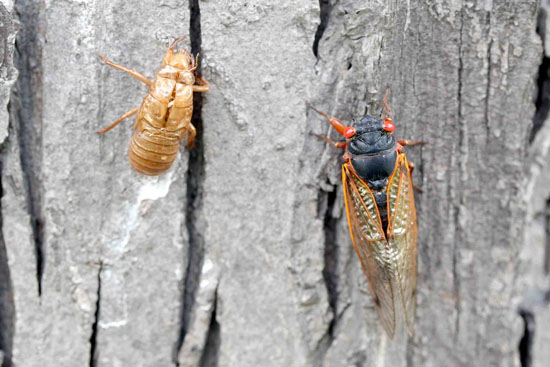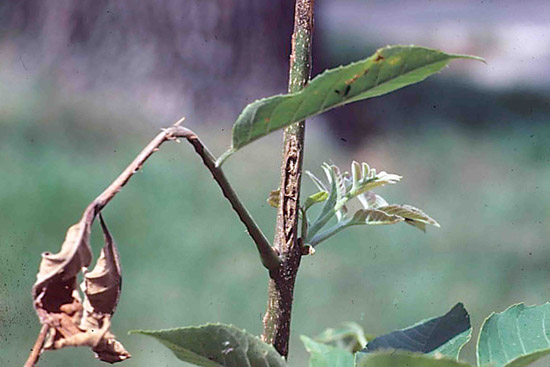Issue 5, May 26, 2015
Periodical Cicada
Periodical cicadas have emerged in southern Illinois. This is a 13-year brood referred to as Marlatt's Brood XXIII or the Lower Mississippi River Valley Brood. This brood touches only small portions of Illinois, emerging in western Kentucky and Tennessee, southeastern Missouri, eastern Arkansas, most of Mississippi, and the eastern half of Louisiana. It emerges in southeastern Illinois in Crawford, Lawrence, and Wabash counties; in southwestern Illinois, in Alexander, Pulaski, Union, Jackson, southeastern Perry, and the western edges of Williamson, Johnson, and Massac counties. This brood emerged in early May and will be present for 6 to 8 weeks.
Feeding is done primarily by nymphs sucking sap out of roots. Where periodical cicadas are numerous, tree growth is reduced the last few years before adult emergence when nymphs are larger and consuming more sap. Even so, this growth reduction is not considered important enough to warrant control. Adult cicadas feed by sucking sap out of stems, but not enough to cause appreciable damage. The adult stage exists primarily for reproduction.

Periodical cicada and nymphal skin on trunk.
Males sing during the daytime to attract females to them for mating. After 2-3 weeks, the males die off, so the singing stops. Females live a few weeks longer to develop and lay their eggs. They insert their eggs through slits they make in stems up to 2 inches in diameter. These eggs hatch in the fall into nymphs that free-fall to the ground. They tunnel into the soil, find a root, and feed there for the next 13 or 17 years. Although they may feed on several different roots over the years, they do not burrow more than a few inches.
In high-emergence areas, enough egg-laying occurs to weaken stems, causing them to wilt and snap in windy conditions. On established trees and shrubs, this causes aesthetic damage but no real threat to overall plant health. However, oviposition into trunks up to 2 inches in diameter can cause the trunk to snap off, severely damaging or killing young trees. We recommend against planting small transplants the year before emergence to avoid damage.

Periodical cicada egg-laying damage on twigs.
The next emergence of periodical cicadas in Illinois will be in 2020 in the Chicago collar areas of Cook, DuPage, Lake and Will Counties. This is the Northern Illinois sub-brood, which is apparently part of Marlatt's Brood XIII, a 17 year brood. It emerged first in 1969, 13 years after the previous emergence and has continued to emerge every 17 years. Periodical cicada life cycles are 13 years in the southern U.S. and 17 years in the northern U.S. Those broods north of the Mackinaw River just north of Bloomington, IL are 17 years; those south of that river's latitude are 13 years.
Trunks of susceptible trees can be wrapped or caged to reduce egg-laying damage. Emergence will not be heavy in housing developments and other areas where the trees and shrubs were removed within the past 50 to 100 years. Such activity kills the root systems and thus the cicada nymphs feeding on them. Periodical cicadas are slow to invade new areas, primarily because they get the chance only every 13 or 17 years when the adults are out.
Several insecticides are labeled and effective in killing large numbers of adults. However, in heavily infested areas, insecticide spraying causes little or no reduction in egg-laying damage, so treatment is normally not recommended. For additional information, go to the University of Illinois Extension web site, Cicadas in Illinois, at http://web.extension.illinois.edu/cicadas/. (Phil Nixon)
Author:
Phil Nixon